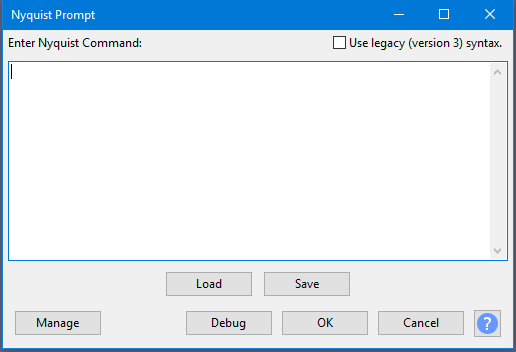Nyquist Prompt
- Accessed by:

Enter Nyquist Command
Type the command as required. Enter on the keyboard moves the cursor to a new line. The last entered code is stored in the pluginsettings.cfg file in Audacity's folder for application data so is retained after exiting Audacity.
Plugin GUI can be tested if you include complete Nyquist Plug-in Headers. The Nyquist Prompt interprets header comments to produce a plug-in of the defined type on the fly. By default the plug-in is a process type, though other type may be created by including the appropriate header.
Use legacy (version 3) syntax
When selected, commands entered in the main text window will be interpreted as the "version 3" code. Support for version 3 syntax is provided for backward compatibility only and is not recommended for new code. When not selected (default), commands entered in the main text window will be interpreted as "version 4" code.
Version 4 code includes a number of variables that are not available in version 3. In particular, the S variable is no longer used to pass sound from Audacity to Nyquist. In version 4 the S variable has been replaced by *TRACK*. Full details about the difference between version 3 and version 4 code can be found in the Audacity wiki.
Buttons
Editing or making Nyquist plug-ins
- Load a Nyquist plugin or script file saved with .ny extension.
- Save the current contents of the editor window as an .ny file.
Presets
- Opens a dropdown menu where you can save the window contents as a preset then reload those contents by selecting the preset. You can also see some descriptive text about the plugin. For details see Manage presets.
Others
- Clicking this button redirects error messages from Audacity's error log to a non-editable "Debug" window. An empty debug windows indicates that no errors were detected. Click to close the debug window, or using the keyboard; hold Ctrl on Windows (or ⌘ on Mac) then press Enter.
- Applies the code to the waveform selection without debug output. Your entered code will be retained next time you open Nyquist Prompt in the Audacity session. Using the keyboard hold Ctrl on Windows (or ⌘ on Mac) then press Enter. Using the keyboard on Linux, hold down Alt and press o.
- No code is processed or debugged. Any code you entered after opening the window this time will be discarded.